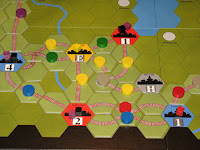
I played
Tide of Iron tonight. Where do I begin...
We started at 7pm, opened the box, laid out all the components, punched and punched and punched, setup the first scenario, played it, put it away. And it was barely 3am.
Punching and organizing the bits took about an hour. Putting the game away took about 20 minutes. See those cases in the image? I need some of those. That would easily save 45 minutes per session.
Setup was about an hour, but only because I had to describe some of the rules to make the decisions meaningful.Then another 30 minutes to go over command, cards, turn sequence, movement and combat. The first game turn was about 90 minutes. Turns got progressively faster--maybe as fast as 20-30 minutes.
In the first scenario, the Americans are holding a line on one end of a 9-board map (3x3). The Germans must occupy 3 hexes of this line at the end of any game turn to win. The Americans must prevent this. The Germans get the use the Command and Morale decks, but the Americans get Reinforcements and Support. It really looks bad for the Germans, but my opponent was up for the challenge.
I lost a double machine gun squad early on. I really thought I would be overwhelmed, but my stream of reinforcements--albeit regular infantry--was enough to fill the gaps the Germans were blasting in my front lines. My favorite move was to use combined fire (4 squads) against the mighty Panzer (in open ground) which resulted in heavy damage. It could no longer move, but it could fire at half firepower for the rest of the game.
As is done in
ASL, we decided to create a verbal notation for attacks. A normal attack with 4 black dice and 2 red we called a "4-2". A long range suppressive attack with 5 black dice and 1 red we called an "L-5-1-S". The above combined fire attack on the tank was a...oops! As I am typing this, I realized we played that wrong. Infantry has a range of 1 against vehicles. We did, however, remember that all the supporting units fired at half firepower. This kind of thing will likely happen often in your first game. There are quite a lot of rules to wrap your head around. Not really exceptions. Each unit type just has its own characteristics in various situations.
Contrary to all expectations, I didn't have to run to the computer to check
BGG for a rules question once. The rulebook isn't perfect, but we managed to figure out stuff that wasn't 100% clear.
ComponentsThe boards are so warped! Just kidding. They are solid and flat. Did I mention they are flat? The map graphics are kind of low-res and blurry, but at least they are very functional and not harsh in the least. All the cardboard bits are thick and colorful--very nicely chosen icons and colors to contrast the boards and plastic. The men were a little smaller than I expected, but after handling them, I don't know how you could make them bigger without making everything else bigger. I didn't have much trouble fitting infantry into the bases, but it does take a while. All in all I'm pretty happy with the production.
MechanicsThis is a solid game. You are playing not only a positional game, but also a game of management of command (which lets you buy initiative and cards that give you cool benefits), unit composition, using special abilities, careful timing, misdirection, and risk. For example, mortars can only fire at enemy units that can be seen by one of your non-fatigued units. If you wait too long to use them, you may have no "forward observers" left. Units in Op Fire mode (waiting to shoot at moving enemy units) become fatigued if they get pinned or disrupted, and a savvy opponent will know when to take advantage of this.
The normal/suppressive fire concepts really work well. In fact, suppressive fire can be deadlier than normal fire. If you are will to use up 3 units (and 3 actions), you can take an enemy unit from normal to pinned to disrupted to routed (eliminated) with only 1 resulting hit each attack. Leaders play a huge role, especially in their ability to remove disruption markers, and to allow pinned units to fire. Leaders and elite units increase effective cover against suppressive attacks. Squads with medic specialization increase effective cover against normal attacks, and can heal (replace) lost men.
I really felt like I had complete control over my fate, and many ways to accomplish my goals. In fact, the more I understood how the mechanics worked together, the harder it was to decide what to do. I really enjoyed this first game. The only thing that might give me pause to "whip it out and play a quickie" is the setup time. It really is a beast. When we play it, it will likely be the only game we play that session. I expect our next play of this same scenario to take about 3 hours.
I'm probably ordering
Descent with my next game order. I now need more space for my games! Maybe I can get by without a bed?...
Tide of Iron image by WhereAreTheBlackDice
 I pushed for Age of Steam again this week since we may lose our borrowed copy. My second session did little to alter my feelings about the game, but some of the warts are starting to show themselves. I'll get to that later.
I pushed for Age of Steam again this week since we may lose our borrowed copy. My second session did little to alter my feelings about the game, but some of the warts are starting to show themselves. I'll get to that later.







